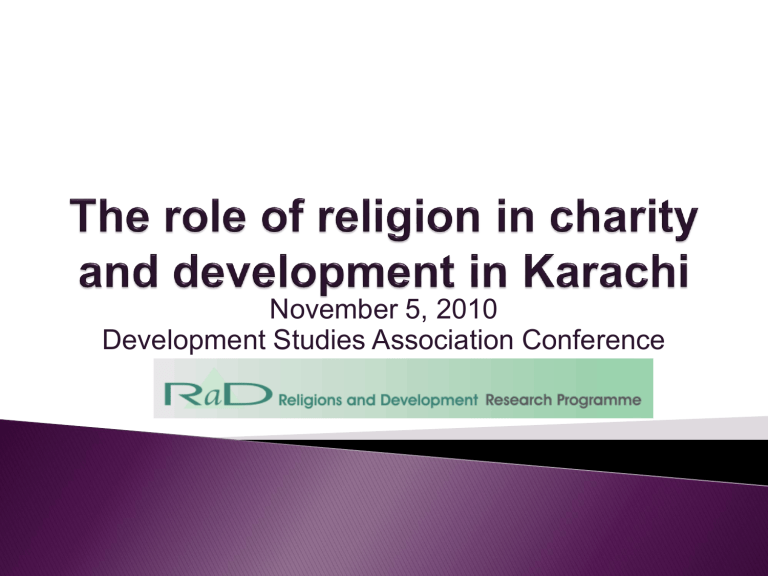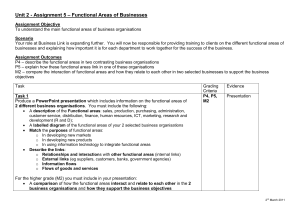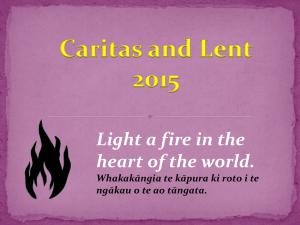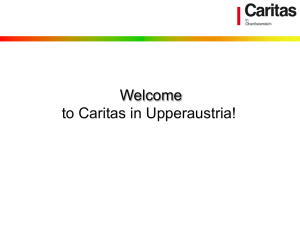*Faith-based Organisations*, Religious Identity and Development in

November 5, 2010
Development Studies Association Conference
Overview of Presentation
Rationale
Background
Methodology
Profile of organisations
Comparison of organisations (amongst each other)
Comparison with ‘NGOs’
Conclusions
Rationale for the Study
Although religion has been central in the development and formation of Pakistan as well as in the history of charitable and philanthropic activities in the region (e.g. temples, khanqas, madrasas, missionaries), very little is known about ‘faith-based organisations’ in this context.
The aim of this study was to identify whether ‘FBOs’, as they have been understood in the literature, exist at all in Pakistan, and if so
What contribution do FBOs make to processes of development and
How are they distinctive from ‘secular’ NGOs? Is this a valid distinction at all in the Pakistani context?
Pakistan’s largest and arguably most diverse city as well as its economic centre – population of 12 million
Multiple waves of migration – Muhajirs, Punjabis,
Sindhis, Balochis, Pathans
Religious diversity – Christians, Hindus, Parsis,
Shias, Sunnis
Stratified along the lines of ethnicity, religion and class
History of humanitarianism beginning with Partition
Qualitative methods and case studies
The research team aimed to identify organisations across religious traditions and across a spectrum of religiosity working in the same sector and geographical area
Research conducted over five months in two phases mainly in Karachi
Interviews conducted mostly with senior staff of 6 organisations because of methodological challenges
Total of 83 interviews with staff, volunteers and some beneficiaries
Challenges in Gaining Depth
Many organisations do not have long-term relationships with beneficiaries
If they do, they prefer not to publicise because of the tradition of ‘giving quietly’ and not embarrassing people
They are not used to outside scrutiny largely because they depend on individual donations, and they also have no need to impress the outside world
Fear around the question of religion in Pakistan since the Zia period (80s) and the war on terror
The Al Khidmat Network
Welfare wing of the Jamaat-e-Islami
Founded at different times since Partition
Includes several organisations: Al Khidmat
Foundation, Al Khidmat Welfare Society, Al
Khidmat Khawateen and others
Welfare-related activities: education, health, material assistance, relief
Rely on individual, religious donations (zakat, hides from qurbani)
Volunteer-run with some paid support staff
Alamgir and Saylani Welfare Trusts
Urban welfare trusts
Founded in 90s
Focused on welfare and material assistance
(Alamgir: medical; Saylani: food programmes)
Provide religious services (hajj, qurbani, istikhara)
Rely on individual religious donations
Rely on paid staff rather than volunteers
Behbud Association
National membership-based organisation led by urban, elite women
Founded in 1967 – Karachi branch established in
1970
Combine welfare and development – schools, clinics, income generation focused on women
Rely on individual religious and general donations and a limited amount of institutional support
Volunteer-run, staffed by paid employees
Edhi Foundation
Largest national charity
Established in the 1950s
Material assistance and relief – ambulance services, orphanages, homes for the destitute
Family-run organisation
Relies on individual religious donations
Paid staff
Caritas
Part of Caritas International - an international network of Catholic organisations
Established in 1965 in Pakistan
Head office in Lahore and diocesan offices in
Karachi, Hyderabad, Quetta, Rawalpindi,
Faisalabad, Multan
Works on relief and development in the form of community mobilisation
Relies on funding from Caritas national offices
Paid staff
Comparison of Organisations
Spectrum from welfare to development
◦
Edhi, Alamgir/Saylani, Al Khidmat focus largely on welfare and relief
◦
Behbud and Caritas provide relief and welfare but also include longer-term development projects
Depend largely on individual, religious donations
◦
Behbud receives a limited amount of institutional support
◦
Caritas receives funds from other Caritas country offices
Spectrum of religiosity (Berger 2003)
◦
Al Khidmat, Alamgir/Saylani, and Caritas are all explicitly religious
◦
Religion is intertwined with Behbud and
Edhi’s work mostly as a motivating factor for donors
Orangi Pilot Project, Indus Resource Network,
Thardeep Rural Support Programme, and
Sindh Agricultural and Forestry Workers
Association
All are funded through institutional donors
All four work on long term development rather than welfare although some grew out of emergency situations
All present themselves as ‘secular’ or ‘nonreligious’ and are critical of religious-based organisations and charities in general
The term ‘FBO’ is problematic in the Pakistani context
The main distinction is between local charities, for which religion is often intertwined with their work, and professional development organisations, which have no apparent relationship with religion
The more important variable in determining an organisation’s orientation and priorities seems to be its funding sources rather than religion, although the two are related
Religion is intertwined with charity but not with ‘development’
Most organisations avoid the label ‘FBO’ either because religion
(Islam) is taken as a given or because of the negative connotations this term has acquired since the war on terror
Caritas is an exception, which can be explained by its position within an international network that has evolved in relation to wider discourses around ‘development’
Conclusions ( cont.’d)
When analysing the nature of organisations, religion (which itself varies depending on religious group, sect, ideology, politics) must be understood as one variable amongst many, including the social makeup of the organisation, the political and ideological profiles of its members, its origins and position within national and international networks, and its funding sources.






![1[7. MINISTRY OF PRIMARY AND MASS EDUCATION] 1](http://s3.studylib.net/store/data/008790481_1-dc16bd6475807709cfe43fd7dc8fd0e5-300x300.png)